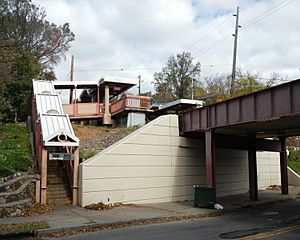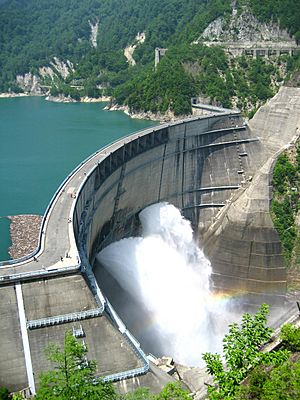Abutment facts for kids
In engineering, an abutment is a strong support structure. You can find abutments at the ends of a bridge or a dam. They are the parts where the main structure rests.
Abutments give important up-and-down and side-to-side support. They also act like a retaining wall. This means they hold back the earth that leads up to the bridge.
Contents
What is an Abutment?
An abutment is a key part of many large structures. It is like a strong "shoulder" that holds up the ends of a bridge or dam. Without abutments, these structures could not stand safely.
Abutments for Bridges
For bridges, abutments are found at each end. They do two main jobs.
Holding Up the Bridge
First, abutments hold up the bridge's main deck. This is the part you drive or walk on. They make sure the bridge stays level and strong. If a bridge has many sections, other supports called piers help in the middle.
Holding Back the Earth
Second, abutments act as a retaining wall. They hold back the soil and rocks that form the path leading to the bridge. This stops the ground from sliding away. It keeps the bridge approach stable.
Abutments for Dams
Dams also use abutments. For dams, the abutments are usually the natural valley walls. These strong natural sides hold the dam in place. Sometimes, engineers build artificial abutments. This happens when the natural ground is not strong enough. For example, the Kurobe Dam in Japan uses artificial concrete abutments.
The Meaning of the Word
The word "abutment" comes from the verb "abut". This word means to "touch by means of a mutual border". So, an abutment is a structure that touches and supports another.
Images for kids
-
Brick abutment supporting disused tramway over the Yass River in Yass, New South Wales
See also
 In Spanish: Estribo (ingeniería) para niños
In Spanish: Estribo (ingeniería) para niños




